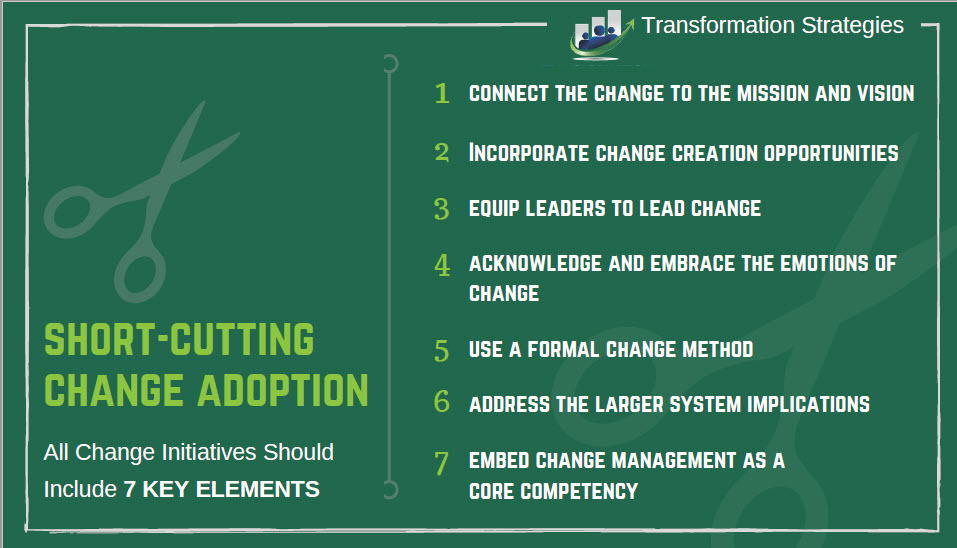7 Secrets to Short-Cutting Your Change Adoption Timelines
We’ve all heard it said, “Change is Constant” and there’s no arguing that our organizations are subject to high volumes of it these days. Yes….the current adage that “change is the new norm” is true!
Interestingly though many organizations still view managing change as a “nice to have” or as a “project to manage”.
Meaning one hires an outside “consultant” to manage the specific change and leaves when completed.
Organizations that are “seeing the light” and incorporating change management practices into their everyday practices still wrestle with the length of time it takes to move the “transformation” needle forward and realize adoption.
And given that “change is the new norm”, faster speed of adoption has to also become the new norm.
Listed below are 7 secret steps you can take to shortcut the change adoption cycle times in your organization:

1. Connect the Change Purpose to the Organization’s Mission/Vision
People choose to work at companies that align to their personal values and they will better engage with the specific changes you want to implement when they see a clear connection between it and your organizational mission and vision. A financial client of mine that was implementing a significant transformational change made sure all communications distributed ALWAYS linked the purpose of the change back to the higher purpose of the organization’s mission. Needless to say, people engaged.
2. Incorporate Change Creation Opportunities
People engage with what they help create! If you want buy-in, get them involved in the process of co-creating their change strategies. Provide opportunities for front line employees to be involved. My partners and I use Whole Scale™ methodology that gathers together representatives from across the entire organizational system to discuss and craft the change strategy as “one heart, one mind”. We’ve seen entire organizations shift their mindsets 180 degrees within just a few days, leaving the workshops aligned and globally committed to clear action plans they’ve agreed to with each other. Just engaging people in the dialogue begins the processes of co-creation and catapults your change adoption forward.
3. Equip Your Leaders to Lead Change Adoption
We know that organizational change happens – one person at a time. Your leaders are your greatest leverage in helping individuals transition through change because they are embedded with the front line and have the strongest influence with their direct reports. It’s unfair to ask your leaders to lead change and not set them up for success by providing them with the resources, tools and knowledge they need to make that happen. And keep in mind, they are undergoing their own transition while they are being tasked to lead others through the change.
4. Acknowledge and Embrace the Emotions of Change
Elisabeth Kubler Ross’s grief work is important to pay attention to when implementing change initiatives. All the varied human emotions of grief such as shock, denial, frustration, depression, anger and bargaining are at play and minimizing them as a reality serves only to lengthen your change adoption timeline. Openly acknowledge the feelings and emotions people might have. I witnessed a senior executive at one of my large pharmaceutical clients speak directly to these emotions when launching a new business operating strategy. One would think that his transparent candidness about the fact that the change would be difficult, scary and frustrating at times, would have triggered a mass exodus by employees. Instead the effect was the exact opposite. The respect he garnered for himself and the impending change created a cohesion and commitment from people in the organization to get engaged and make it happen. Your employees are hungry for transparent leadership.
5. Utilize a Formalize Change Management Method
A colleague of mine once said to me “You can schedule deployment but you can’t schedule adoption”. These words have never rung truer in advising my clients through their changes processes over the past 30 years. As humans, we know we don’t transition in a linear fashion. Sometimes it’s two steps forward, one step back. However, when implementing change, you can utilize a formal change management methodology to develop roadmaps with milestones that provide “guard rails” and guide you towards meeting your change objectives with intention. Leaving your change adoption up to chance will elongate your timelines and introduce a lot of confusion. Just don’t let the methodology become the master.
6. Address the Larger System Implications of Your Change Adoption
I’ve often been asked how my undergraduate degree in Biology has informed my life’s work in organizational development and change. Anyone who has studied the ecosystem of a cell understands that when one part of the cell is impacted, other parts are also. Organizations are ecosystems with intricate connections across the enterprise. Change one part of the system and the ripple effect is felt throughout. If you want to shorten your adoption timelines, it’s imperative to consider all systemic implications and develop strategies to address them.
7. Embed Change Management Skills as a Core Competency
Integrating the skills of leading and managing change as part of how your daily work gets done fosters agility and nimbleness in your organization. Businesses that are intentional about embedding these competencies at all levels throughout their employee base will find themselves better equipped to quickly pivot and remain competitive in the marketplace. When the skill sets of navigating change have become second nature and your organization’s “way of being”, change adoption will be happening instantaneously at the moment it needs to occur. Build this capacity internally and watch your organization fly!
Join my mailing list for more resources like this!






